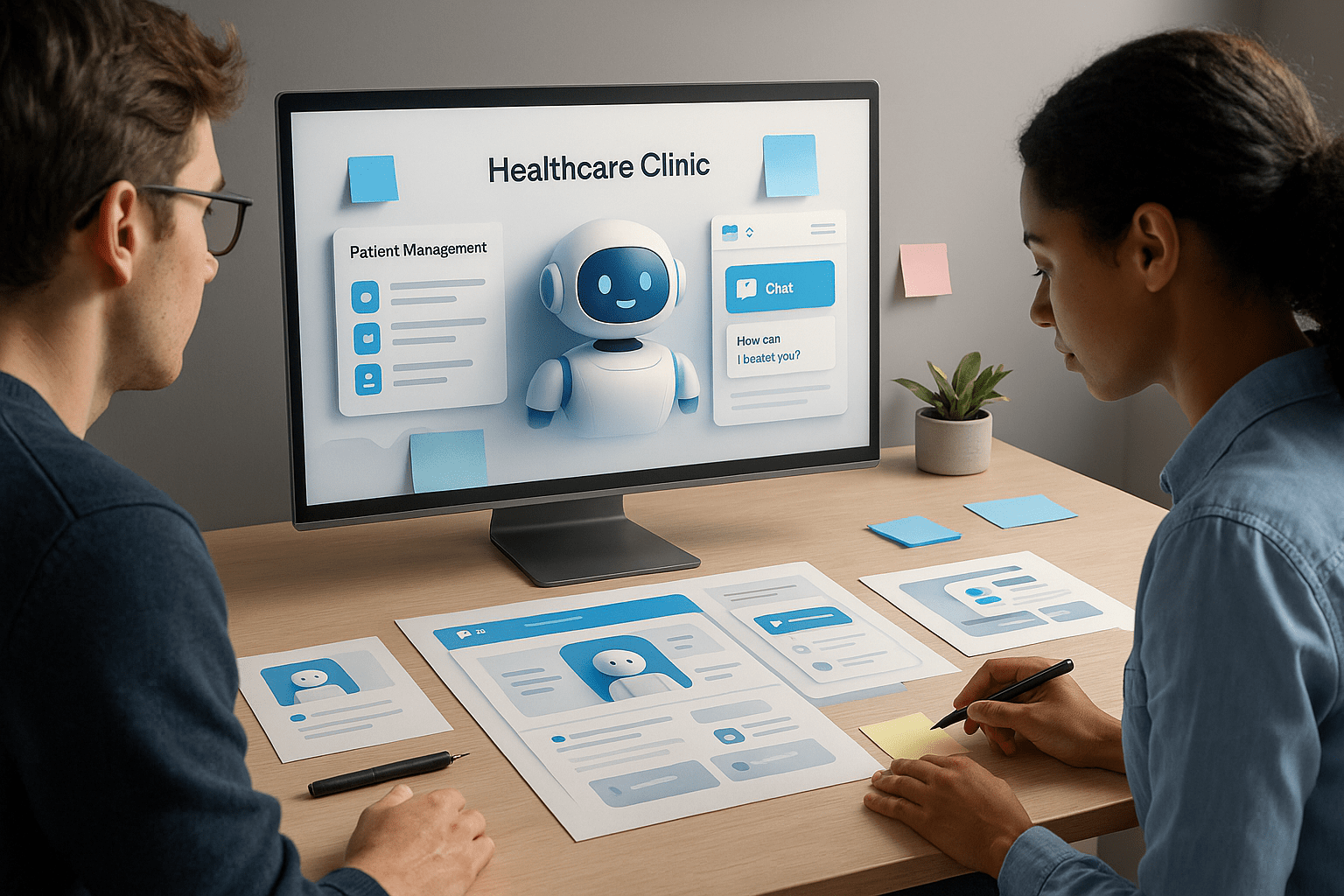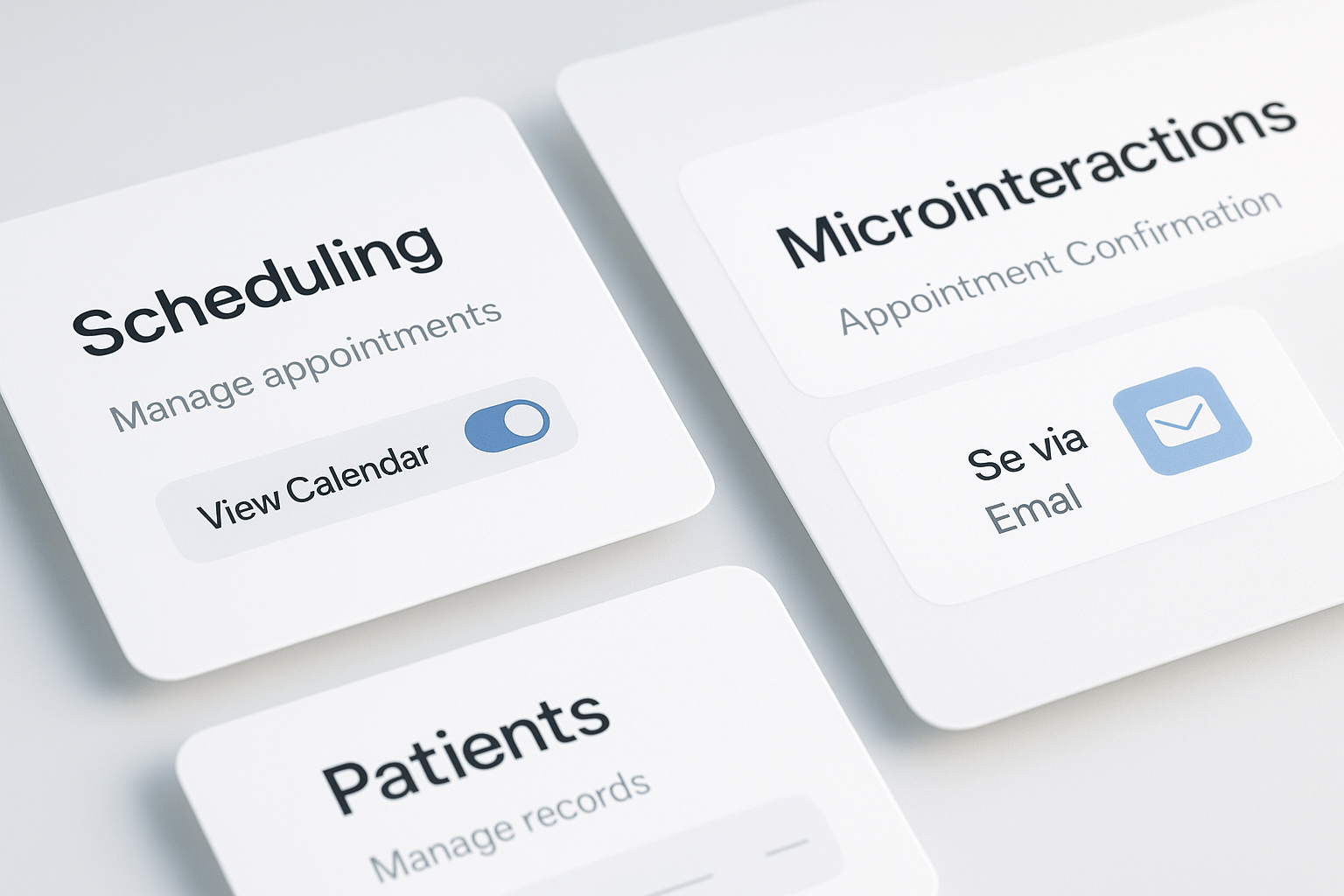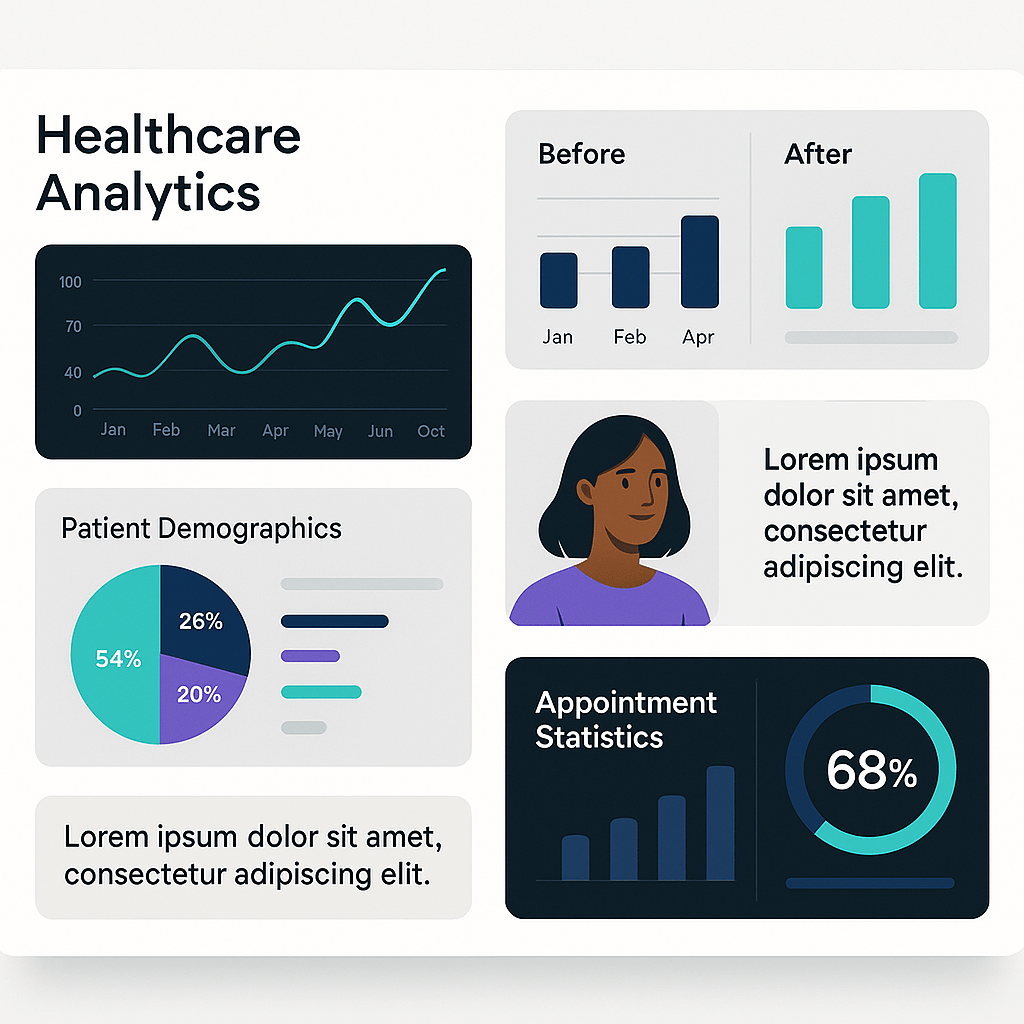Unlocking Healthcare Clinics Growth with Graphic Design
by Design Delulu Editorial · September 14, 2025

In today's competitive healthcare landscape, first impressions matter more than ever. Healthcare clinics face unique challenges in building trust, communicating complex medical information, and standing out in an increasingly crowded market. While medical expertise remains paramount, the visual presentation of your clinic can significantly impact patient acquisition, retention, and overall business growth.
Graphic design isn't just about making things look pretty—it's a strategic tool that addresses core business challenges healthcare clinics face daily. From building patient trust through professional branding to simplifying complex medical information through visual communication, effective graphic design can transform how your clinic connects with patients and grows your practice.

Why Healthcare Clinics Need Graphic Design
Healthcare clinics operate in a unique environment where trust, professionalism, and clear communication are critical for success. Yet many clinics struggle with common challenges that graphic design can effectively address.
Key Challenges Healthcare Clinics Face
Patient Trust and Credibility Issues
Healthcare is inherently personal and requires immense trust. Patients need to feel confident in their healthcare providers before they even step through the door. Outdated, unprofessional visual materials can undermine this trust before a patient ever meets your medical staff. Studies show that patients form opinions about healthcare quality within seconds of encountering clinic materials, whether online or in-person.
Complex Information Communication
Medical information is often complex and intimidating for patients. From explaining procedures to communicating health insurance details, clinics constantly need to break down sophisticated concepts into digestible information. Poor visual communication can lead to patient confusion, missed appointments, and reduced compliance with treatment plans.
Competitive Differentiation Struggles
With healthcare options expanding, clinics must differentiate themselves from competitors while maintaining professional standards. Generic, template-based designs make it difficult to stand out and communicate unique value propositions that attract and retain patients.
Inconsistent Brand Experience
Many clinics have disconnected visual elements across touchpoints—from websites and social media to printed materials and signage. This inconsistency can confuse patients and weaken brand recognition, ultimately impacting patient loyalty and referrals.
How Graphic Design Solves These Problems
Building Instant Trust Through Professional Design
Strategic graphic design creates visual cues that immediately communicate professionalism, expertise, and care. Clean, modern designs with appropriate medical imagery and color psychology help patients feel comfortable and confident in your services. Professional branding elements like logos, color schemes, and typography work together to create a cohesive image that patients associate with quality healthcare.
Simplifying Complex Medical Information
Well-designed infographics, patient education materials, and digital displays can transform complicated medical concepts into easily understood visual content. This improves patient comprehension, reduces anxiety, and leads to better health outcomes. Visual hierarchy and thoughtful information design help patients focus on the most important details while reducing cognitive overload.
Creating Memorable Brand Differentiation
Custom graphic design helps healthcare clinics develop unique visual identities that reflect their specific values, specialties, and patient care approaches. Whether you specialize in pediatrics, geriatrics, or urgent care, targeted design elements can immediately communicate your focus and attract your ideal patient demographic.
Ensuring Consistent Patient Experience
Comprehensive brand guidelines and design systems ensure every patient touchpoint reinforces your clinic's professional image. From appointment cards to website design, consistent visual elements create a seamless experience that builds recognition and trust over time.

Essential Features of Graphic Design for Healthcare Clinics
Effective healthcare clinic design requires specific elements that address both aesthetic and functional needs while complying with healthcare industry standards.
Must-Have Design Elements and Tools
Professional Logo and Brand Identity System
Your clinic's logo serves as the foundation for all visual communications. It should be simple, memorable, and appropriate for medical settings. A comprehensive brand identity system includes color palettes that convey trust and calm (often blues, greens, and neutral tones), typography that's both professional and readable, and imagery guidelines that maintain consistency across all materials.
Patient Education Materials and Infographics
Visual education tools are essential for healthcare communication. Well-designed infographics can explain procedures, medication instructions, and preventive care measures more effectively than text alone. These materials should use clear hierarchy, appropriate medical illustrations, and accessible language that patients of all educational backgrounds can understand.
Digital Presence Optimization
Your website, social media profiles, and online directories are often the first places potential patients encounter your clinic. Professional web design with clear navigation, appointment booking functionality, and mobile responsiveness is crucial. Social media templates maintain consistency while allowing for regular patient education content sharing.
Wayfinding and Environmental Graphics
Clear signage and wayfinding systems reduce patient stress and improve operational efficiency. This includes exterior signage, interior directional signs, room identification, and digital displays for announcements or educational content. These elements should complement your overall brand while prioritizing functionality and accessibility compliance.
Real-World Implementation Examples
Pediatric Clinic Success Story
A children's healthcare clinic transformed their patient experience by implementing playful yet professional graphics throughout their space. Colorful wayfinding featuring friendly animal characters helped young patients navigate independently while reducing anxiety. Educational posters about healthy habits used engaging illustrations that both children and parents found approachable. The result was improved patient satisfaction scores and increased referrals from happy families.
Urgent Care Visual Communication System
An urgent care center developed a comprehensive visual system for managing patient flow and communication. Digital displays showed real-time wait times and health tips, while color-coded signage helped patients understand different service areas. Clear, illustrated forms reduced intake errors and improved overall operational efficiency.
Specialty Practice Brand Differentiation
A dermatology practice used sophisticated, spa-like design elements to differentiate from clinical competitors while maintaining medical credibility. Professional photography showcasing results, elegant color schemes, and premium materials created an upscale experience that attracted patients seeking cosmetic services while maintaining trust for medical dermatology needs.

Common Mistakes to Avoid
Even well-intentioned graphic design efforts can backfire if they don't consider healthcare-specific requirements and patient needs.
Typical Pitfalls in Healthcare Clinic Design
Over-Relying on Medical Clichés
Many healthcare designs default to overused imagery like stethoscopes, red crosses, and generic medical stock photos. While these symbols have their place, relying too heavily on clichés makes your clinic blend in rather than stand out. Patients see these same visual elements everywhere, reducing their impact and memorability.
Ignoring Accessibility Requirements
Healthcare facilities must serve patients with diverse abilities and needs. Designs that don't consider color contrast for visually impaired patients, font sizes for elderly patients, or language barriers for diverse communities can exclude potential patients and may violate accessibility regulations.
Inconsistent Visual Identity Across Touchpoints
Using different fonts, colors, or design styles across your website, printed materials, and physical space creates confusion and weakens brand recognition. Patients may not realize they're interacting with the same healthcare provider, reducing the effectiveness of your marketing efforts and patient education initiatives.
Prioritizing Aesthetics Over Functionality
While beautiful design is important, healthcare materials must prioritize clear communication and usability. Overly decorative fonts that are difficult to read, complex layouts that bury important information, or color schemes that don't work in medical lighting can actually harm patient experience despite looking impressive.
Neglecting Cultural Sensitivity
Healthcare clinics serve diverse populations with different cultural backgrounds, languages, and health beliefs. Design choices that seem neutral to one group may be problematic for others. Color meanings, imagery, and even layout preferences can vary significantly across cultural groups.
How to Design Better for Healthcare
Focus on Clear Communication First: Every design decision should support clear, accessible communication. Use high contrast colors, readable fonts, and logical information hierarchy. Test materials with actual patients to ensure they understand the intended message before finalizing designs.
Develop Comprehensive Brand Guidelines: Create detailed brand standards that specify exactly how to use logos, colors, fonts, and imagery across all applications. This ensures consistency whether materials are created in-house or by external vendors. Include specific guidelines for digital applications, print materials, and environmental graphics.
Invest in Professional Photography: Generic stock photos can make your clinic look impersonal and generic. Professional photography of your actual facility, staff, and (with permission) patients creates authentic connections and builds trust. Ensure photos reflect your patient demographic diversity and maintain appropriate medical privacy standards.
Plan for Scalability and Updates: Healthcare regulations, services, and staff change regularly. Design systems that can easily accommodate updates without requiring complete overhauls save time and maintain consistency. Use modular design approaches that allow for easy customization while maintaining brand integrity.
SEO and Growth Best Practices
Graphic design and search engine optimization work together to improve healthcare clinic visibility and patient acquisition.
Optimization Tips Specific to Healthcare Clinics
Local SEO Through Visual Branding
Consistent visual branding across online directories, Google My Business profiles, and review sites helps search engines and patients recognize your clinic. Use the same logo, colors, and imagery across all platforms to strengthen local search presence. Include location-specific imagery that helps patients identify your physical presence in the community.
Content Marketing Through Visual Storytelling
Create shareable infographics and visual content that address common patient questions and health topics relevant to your specialties. These materials can attract organic traffic while establishing your clinic as a trusted health information source. Visual content performs better on social media platforms, expanding your reach beyond traditional search results.
Mobile-First Visual Design
With over 60% of healthcare searches happening on mobile devices, your visual design must prioritize mobile user experience. This means larger fonts, simplified navigation, touch-friendly interface elements, and fast-loading images optimized for various screen sizes and internet speeds.
Conversion-Focused Design Elements
Strategic placement of appointment booking buttons, contact information, and clear calls-to-action can significantly improve website conversion rates. Use contrasting colors and clear visual hierarchy to guide potential patients toward desired actions like scheduling appointments or calling your clinic.
Leveraging Graphic Design for Visibility and Results
Patient Review and Testimonial Integration
Well-designed testimonial graphics and review displays can improve both search engine optimization and patient conversion. Visual testimonials are more engaging than text alone and can be easily shared across multiple platforms. Include patient photos (with permission) and specific details about positive outcomes to build trust and credibility.
Educational Content Libraries
Develop comprehensive libraries of branded educational materials that patients can access online. This content serves multiple purposes: improving search rankings for health-related keywords, providing value to current patients, and attracting new patients searching for health information. Consistent branding on all educational materials reinforces your clinic's expertise and authority.
Social Proof Through Visual Case Studies
Before-and-after photos, treatment progression documentation, and success story infographics (while maintaining patient privacy) can significantly impact both SEO and patient decision-making. These materials demonstrate expertise while providing content that patients are likely to share and engage with online.
Analytics-Driven Design Improvements
Use website analytics, social media insights, and patient feedback to continuously refine your visual design approach. Track which types of visual content generate the most engagement, which design elements lead to appointment bookings, and how patients interact with your digital materials. This data-driven approach ensures your design investment delivers measurable business results.
Conclusion
Healthcare clinics that invest in strategic graphic design gain significant competitive advantages in patient acquisition, retention, and overall business growth. By addressing core challenges like trust-building, information communication, and brand differentiation through thoughtful visual design, clinics can create more effective patient experiences while improving operational efficiency.
The key lies in understanding that healthcare graphic design isn't just about aesthetics—it's about creating clear, accessible, and trustworthy communication that serves both patient needs and business objectives. From professional branding systems to patient education materials, every design element should support your clinic's mission of providing excellent healthcare while building a sustainable practice.
Remember that effective healthcare design requires ongoing attention and refinement. As your clinic grows, services evolve, and patient needs change, your visual communication strategy should adapt accordingly. The investment in professional graphic design pays dividends through improved patient satisfaction, increased referrals, and stronger competitive positioning in your healthcare market.
👉 Ready to improve your healthcare clinic with graphic design? Explore Graphic Design at Design Delulu to see how professional design can transform your practice and accelerate your growth.